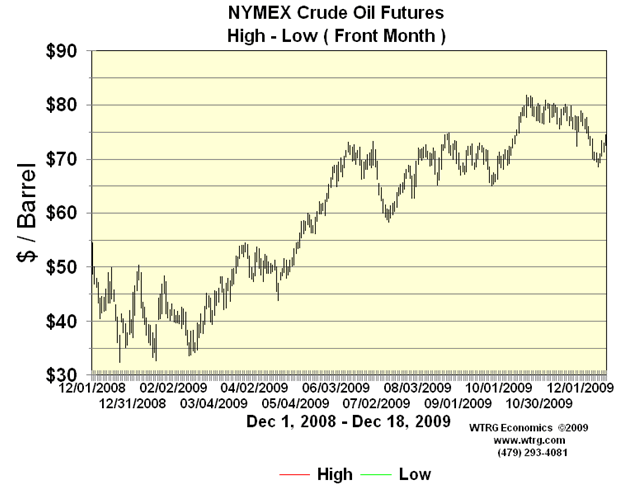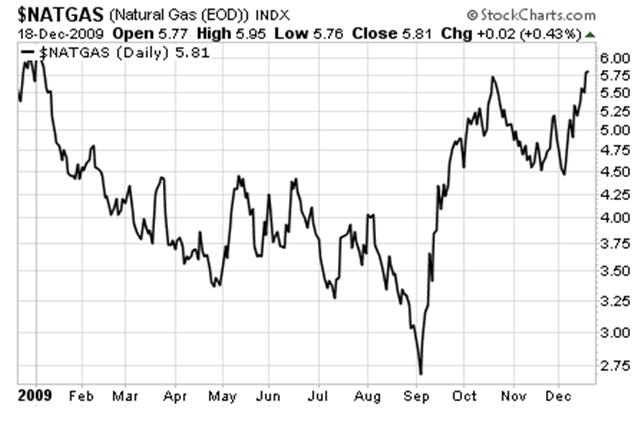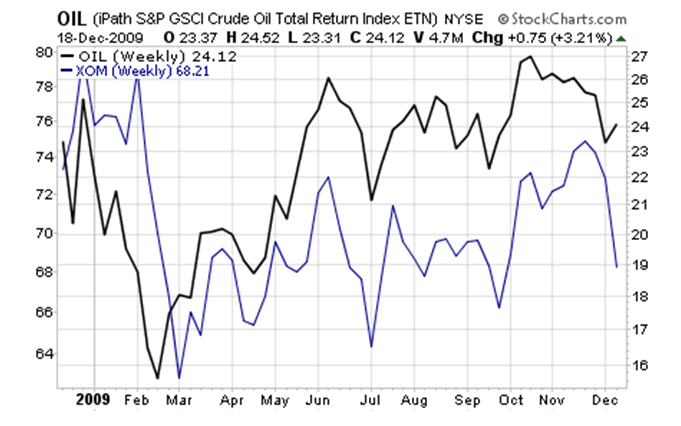Why Crude Oil Isn’t Safe For Individual Investors
Commodities / Crude Oil Dec 23, 2009 - 01:36 AM GMTBy: Graham_Summers
 A year ago, I wrote an essay titled, “The Most Important Fact to Know About Oil Investing.” The fact I was referring to was that NO ONE KNOWS WHERE OIL IS HEADING.
A year ago, I wrote an essay titled, “The Most Important Fact to Know About Oil Investing.” The fact I was referring to was that NO ONE KNOWS WHERE OIL IS HEADING.
Of course, I was being somewhat “tongue-in-cheek” with my analysis, but the reality is that oil investing today has virtually nothing to do with fundamentals or reality, and everything to do with speculation.
According to the International Energy Agency, worldwide global demand for oil is currently running at 84.8 million barrels per day. That’s nearly a 2% drop from 2008’s levels of 86.3 million barrels per day. Over the same time period, oil supply actually rose from 85.2 million barrels per day to 85.6 barrels per day roughly 0.5%.
So demand fell and supply rose.
And yet, here’s what oil’s done in 2009:

In plain terms, here we have an investment in which demand is falling, supply is rising, and yet the price has risen roughly 40% for the year. It’s really quite striking especially when you consider oil’s performance next to that of natural gas: a energy commodity that is also closely related to industrial production but more difficult to store (more on this in a moment).

So here we have two energy commodities, one rising 40% and the other roughly break even over the same time period. What gives?
Speculation.
As I mentioned earlier, oil investing today has NOTHING to do with fundamentals and EVERYTHING to do with speculation. You see, in order to store oil all you need to do is rent a warehouse or tanker. In contrast, in order to store natural gas, you need an underground aquifer or some other underground storage facility (natural gas is too explosive to be stored safely above ground in large quantities).
For this reason, oil is the energy commodity of choice for energy speculators and brokerages. Because of a loophole in commodities regulation (one put forth by Goldman Sachs no less), traders at large brokerages can pretend to be oil producers (rather than traders) and therefore are allowed to store huge quantities of oil in warehouses and tankers despite the fact they have absolutely nothing to do with the supply or demand of the commodity.
In plain terms, traders can manipulate the price of oil all they like, storing or releasing it on the market at will regardless of the fundamentals in the industry. If you need further proof of this, consider the performance of oil next to that of Exxon Mobil (XOM), one of the largest oil producing companies in the world.

Granted, there’s no rule that says oil producers need to trade lock step with oil. But still, the divergence between oil prices and oil producers is a bit much to swallow. I’d also like to point out that the divergence became far more pronounced starting in March when the Fed announced its Quantitative Easing Program: this is the point at which oil prices really began to soar as a result of Dollar devaluation. This is especially evident when you price oil in Euros:

Here again we see the impact of speculation on Oil. When you remove Dollar devaluation, the gains are not nearly as pronounced or impressive. Thus, we see that Oil is moving more as an inflation hedge or anti-Dollar trade, than any kind of economic realities.
All in all I hope this analysis makes the following clear:
- Oil is trading largely based on speculation and is completely removed from fundamentals
- Oil’s gains are greatly affected by Dollar devaluation, not economic realities
- Investing in oil has become an “insiders” game in which professional traders and speculators move the commodity at will
And that’s why I steer clear from oil as an investment.
PS. Oil is not the ONLY investment getting manipulated: the entire stock market is being gamed higher so that Wall Street can sucker individual investors back in… only to cut the cord and let the market Crash again. Investors who believe we’re in a new bull market are walking like lambs to the slaughter.
Don’t be one of them.
I’ve put together a FREE Special Report detailing THREE investments that will explode when stocks start to collapse again. I call it Financial Crisis “Round Two” Survival Kit. These investments will not only help to protect your portfolio from the coming carnage, they’ll can also show you enormous profits.
Swing by www.gainspainscapital.com/gold.html to pick up your FREE copy!!
Good Investing!
Graham Summers
Graham Summers: Graham is Senior Market Strategist at OmniSans Research. He is co-editor of Gain, Pains, and Capital, OmniSans Research’s FREE daily e-letter covering the equity, commodity, currency, and real estate markets.
Graham also writes Private Wealth Advisory, a monthly investment advisory focusing on the most lucrative investment opportunities the financial markets have to offer. Graham understands the big picture from both a macro-economic and capital in/outflow perspective. He translates his understanding into finding trends and undervalued investment opportunities months before the markets catch on: the Private Wealth Advisory portfolio has outperformed the S&P 500 three of the last five years, including a 7% return in 2008 vs. a 37% loss for the S&P 500.
Previously, Graham worked as a Senior Financial Analyst covering global markets for several investment firms in the Mid-Atlantic region. He’s lived and performed research in Europe, Asia, the Middle East, and the United States.
© 2009 Copyright Graham Summers - All Rights Reserved
Disclaimer: The above is a matter of opinion provided for general information purposes only and is not intended as investment advice. Information and analysis above are derived from sources and utilising methods believed to be reliable, but we cannot accept responsibility for any losses you may incur as a result of this analysis. Individuals should consult with their personal financial advisors.
Graham Summers Archive |
© 2005-2022 http://www.MarketOracle.co.uk - The Market Oracle is a FREE Daily Financial Markets Analysis & Forecasting online publication.



